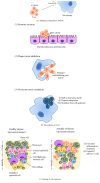Paracoccidioides Spp.: Virulence Factors and Immune-Evasion Strategies
- PMID: 28553014
- PMCID: PMC5434249
- DOI: 10.1155/2017/5313691
Paracoccidioides Spp.: Virulence Factors and Immune-Evasion Strategies
Abstract
Paracoccidioides spp. are dimorphic fungal pathogens responsible for one of the most relevant systemic mycoses in Latin America, paracoccidioidomycosis (PCM). Their exact ecological niche remains unknown; however, they have been isolated from soil samples and armadillos (Dasypus novemcinctus), which have been proposed as animal reservoir for these fungi. Human infection occurs by inhalation of conidia or mycelia fragments and is mostly associated with immunocompetent hosts inhabiting and/or working in endemic rural areas. In this review focusing on the pathogen perspective, we will discuss some of the microbial attributes and molecular mechanisms that enable Paracoccidioides spp. to tolerate, adapt, and ultimately avoid the host immune response, establishing infection.
Figures


References
-
- Restrepo A., Tobón A., Cano L. E. Paracoccidioides brasiliensis. In: Bennett J. E., Dolin R., Blaser M. J., editors. Principles and Practice of Infectious Diseases. 8. Philadelphia, PA: Elsevier; 2015. pp. 2995–3002.
Publication types
MeSH terms
Substances
LinkOut - more resources
Full Text Sources
Other Literature Sources
Miscellaneous

